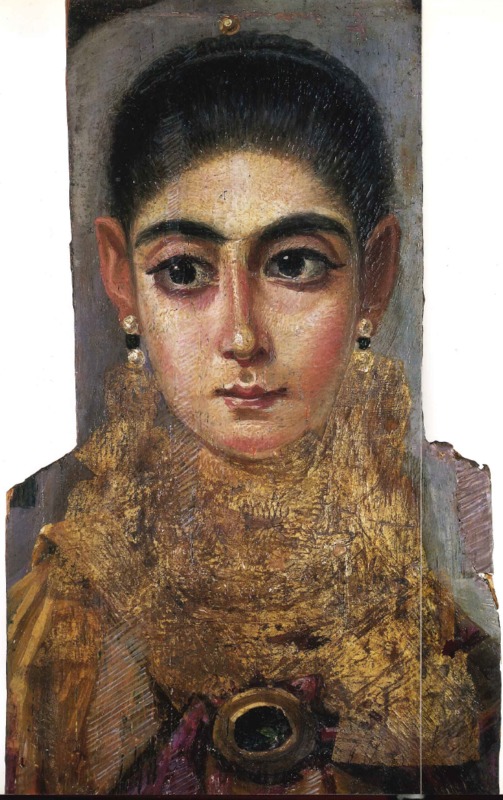The "European"
Title
The "European"
Date
Hadrianic, ca. 117-138 AD
Artist or Workshop
Unknown
Materials
Encaustic and gilt on cedar
Height of the work
42 cm tall
Provenience
Egypt, Antinoopolis
Current Location
Louvre Museum, Paris, France
Sitter Biography
Sitter unknown
Description and Significance
Description:
This mummy portrait depicts a young woman using the encaustic technique. The shape of the panel mimics the sensitively rendered portrait as it is narrow at the head and wider at the shoulders. The woman’s face, with its light, pearly complexion, rosy cheeks, and dark eyebrows and eyelashes, is characterized by large, slightly lowered eyes that gaze rightward instead of forward at the viewer. Her dark hair is drawn back from her face and braided at the crown of her head; the braid is fastened with a carefully painted spherical, gold hairpin. The young woman is wearing a red-purple mantle and elaborate jewelry that consists of a large oval brooch at her breast, pearl earrings that contain a dark-colored stone, and a pearl necklace, hidden by the gold leaf bib that covers her neck and upper bust. There are also a series of white parallel lines that appear throughout the lower part of the composition, signaling repairs.
Significance:
During the Roman period, mummification technique declined and it became more necessary for a substitute likeness for the deceased to be provided. Thus, bust-length painted portraits were created to help the deceased achieve immortality. Therefore, the practice of incorporating the bust style of painting into funerary tradition is a Roman import of Egyptian tradition and was translated into local custom in the mummy portraits. Many mummy portraits, including “The European,” are depicted with Roman hairstyles, jewelry, and clothing that was fashionable at the time. Each individual represented in a mummy portrait is shown at their best. The panel of this particular mummy portrait has been cut down to the shape characteristic of mummy portraits from Antinoopolis. It was dubbed “The European” due to the sitter’s pale complexion. Though the use of gold leaf was often added for funerary purposes, its application in the neck area is unique and suggests that this portrait was commissioned by the local elite. The gilding in the jewelry and around the collar would have been added after the painting process itself was completed.
This mummy portrait depicts a young woman using the encaustic technique. The shape of the panel mimics the sensitively rendered portrait as it is narrow at the head and wider at the shoulders. The woman’s face, with its light, pearly complexion, rosy cheeks, and dark eyebrows and eyelashes, is characterized by large, slightly lowered eyes that gaze rightward instead of forward at the viewer. Her dark hair is drawn back from her face and braided at the crown of her head; the braid is fastened with a carefully painted spherical, gold hairpin. The young woman is wearing a red-purple mantle and elaborate jewelry that consists of a large oval brooch at her breast, pearl earrings that contain a dark-colored stone, and a pearl necklace, hidden by the gold leaf bib that covers her neck and upper bust. There are also a series of white parallel lines that appear throughout the lower part of the composition, signaling repairs.
Significance:
During the Roman period, mummification technique declined and it became more necessary for a substitute likeness for the deceased to be provided. Thus, bust-length painted portraits were created to help the deceased achieve immortality. Therefore, the practice of incorporating the bust style of painting into funerary tradition is a Roman import of Egyptian tradition and was translated into local custom in the mummy portraits. Many mummy portraits, including “The European,” are depicted with Roman hairstyles, jewelry, and clothing that was fashionable at the time. Each individual represented in a mummy portrait is shown at their best. The panel of this particular mummy portrait has been cut down to the shape characteristic of mummy portraits from Antinoopolis. It was dubbed “The European” due to the sitter’s pale complexion. Though the use of gold leaf was often added for funerary purposes, its application in the neck area is unique and suggests that this portrait was commissioned by the local elite. The gilding in the jewelry and around the collar would have been added after the painting process itself was completed.
References
Doxiades, E. 2000. The Mysterious Fayum Portraits: Faces from Ancient Egypt, London, p.213.
Walker, S. (ed). 2000. Ancient Faces: Mummy Portraits from Roman Egypt, New York, pp.14-31.
www.louvre.fr/en/oeuvre-notices/portrait-woman-known-l-europeenne
www.museumlab.eu/exhibition/06/about.html
Contributor
Lauren Kershenbaum
Citation
Unknown, “The "European",” Digital Portrait "Basket" - ARTH488A - "Ancient Mediterranean Portraiture", accessed May 20, 2024, https://classicalchopped2.artinterp.org/omeka/items/show/51.
Item Relations
This item has no relations.

